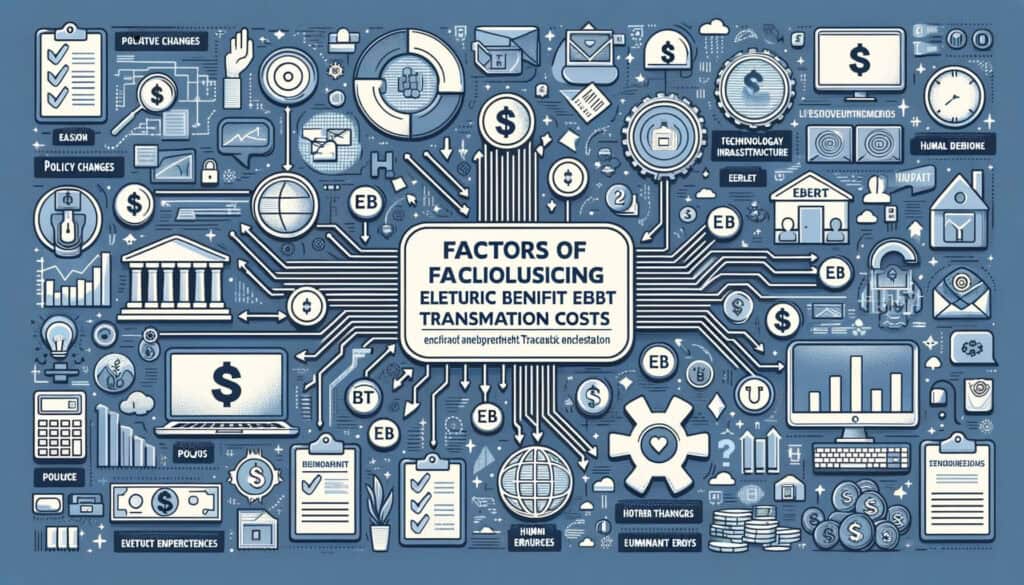
By Sharon Watson April 9, 2025
Electronic Benefit Transfer (EBT) is a system that allows recipients of government assistance programs, such as the Supplemental Nutrition Assistance Program (SNAP), to access their benefits through a debit card. While EBT provides a convenient and efficient way for individuals and families to access their benefits, it is important to understand the transaction fees and cost structures associated with this system.
In this comprehensive guide, we will delve into the basics of EBT transactions, explore the different types of transaction fees, discuss the factors that affect EBT transaction costs, compare fees charged by different providers, shed light on hidden fees and additional charges, and provide strategies to minimize EBT transaction costs.
By the end of this guide, you will have a thorough understanding of EBT transaction fees and cost structures, enabling you to make informed decisions regarding your benefits.
Understanding the Basics of EBT Transactions

To comprehend EBT transaction fees and cost structures, it is essential to have a solid understanding of how EBT transactions work. When a recipient receives their benefits, they are loaded onto an EBT card, which functions like a regular debit card. The cardholder can then use this card to make purchases at authorized retailers, withdraw cash from ATMs, and check their balance.
EBT transactions are processed through a secure network that connects the retailer, the EBT processor, and the government agency responsible for administering the benefits. When a transaction is initiated, the retailer’s point-of-sale (POS) system communicates with the EBT processor to verify the cardholder’s eligibility and available balance. Once the transaction is approved, the retailer receives payment from the government agency, and the cardholder’s balance is adjusted accordingly.
Different Types of EBT Transaction Fees

EBT transaction fees can vary depending on the type of transaction and the provider. It is important to familiarize yourself with the different types of fees to understand how they may impact your benefits. The most common types of EBT transaction fees include:
1. Point-of-Sale (POS) Transaction Fees: These fees are charged to retailers for each EBT transaction they process. The fees are typically a percentage of the transaction amount or a flat fee per transaction. Retailers may pass on these fees to the cardholder in the form of higher prices or surcharges.
2. ATM Withdrawal Fees: When cardholders use their EBT card to withdraw cash from an ATM, they may be charged a fee by the ATM operator. These fees can vary depending on the ATM network and location. It is important to note that some states provide a limited number of free ATM withdrawals per month.
3. Balance Inquiry Fees: Cardholders who check their EBT card balance at an ATM or through a customer service hotline may be charged a fee. This fee is typically a flat rate and can vary depending on the provider.
4. Replacement Card Fees: If a cardholder loses their EBT card or it is stolen, they may be required to pay a fee to obtain a replacement card. This fee is usually a one-time charge and can vary depending on the state and provider.
Factors Affecting EBT Transaction Costs

Several factors can influence the overall cost of EBT transactions. Understanding these factors can help you make informed decisions and minimize your transaction costs. The key factors affecting EBT transaction costs include:
1. Provider Fees: Different EBT processors charge varying fees for their services. It is important to compare the fees charged by different providers to ensure you are getting the best deal. Some providers may offer lower transaction fees but have higher hidden fees, so it is crucial to consider the overall cost structure.
2. Transaction Volume: The number of EBT transactions you make can impact your overall transaction costs. Some providers offer volume discounts for high transaction volumes, while others may charge higher fees for excessive transactions. Analyzing your transaction history can help you determine the most cost-effective provider for your needs.
3. Retailer Participation: The number of authorized retailers in your area can affect your transaction costs. If there are limited retailers accepting EBT, you may have to travel further to make purchases, incurring additional transportation costs. It is advisable to choose a provider with a wide network of participating retailers to minimize your expenses.
4. State Regulations: Each state has its own regulations regarding EBT transaction fees. Some states may cap the fees that retailers can charge, while others may allow retailers to impose surcharges. Familiarize yourself with your state’s regulations to understand how they may impact your transaction costs.
Comparing EBT Transaction Fees of Different Providers

To ensure you are getting the best value for your benefits, it is crucial to compare the transaction fees charged by different EBT providers. While the fees may vary, it is important to consider the overall cost structure, including any hidden fees or additional charges. Here are some key factors to consider when comparing EBT transaction fees:
1. POS Transaction Fees: Compare the percentage or flat fee charged by different providers for each POS transaction. Consider the average transaction amount and estimate the total fees you would incur based on your usage.
2. ATM Withdrawal Fees: Evaluate the fees charged by different ATM networks for cash withdrawals. Some providers may have partnerships with specific ATM networks, offering lower or waived fees for cardholders.
3. Balance Inquiry Fees: Determine if a provider charges a fee for checking your EBT card balance. Consider how frequently you check your balance and calculate the potential cost of this fee over time.
4. Replacement Card Fees: Assess the one-time fee charged by each provider for replacing a lost or stolen EBT card. While this fee may not be a recurring cost, it is important to factor it into your decision-making process.
Hidden Fees and Additional Charges in EBT Transactions
In addition to the standard transaction fees, there may be hidden fees and additional charges associated with EBT transactions. These fees can significantly impact your overall transaction costs, so it is crucial to be aware of them. Here are some common hidden fees and additional charges to watch out for:
1. Monthly Maintenance Fees: Some EBT providers may charge a monthly maintenance fee for cardholders. This fee is typically deducted from the cardholder’s balance and can vary depending on the provider. It is important to consider this fee when comparing different providers.
2. Inactivity Fees: If a cardholder does not use their EBT card for a certain period, some providers may charge an inactivity fee. This fee is typically deducted from the cardholder’s balance and can be avoided by using the card regularly.
3. Paper Statement Fees: While most EBT providers offer online access to transaction history and balance information, some may charge a fee for paper statements. If you prefer receiving paper statements, consider the potential cost of this fee.
4. Customer Service Fees: Cardholders who require assistance from customer service representatives may be charged a fee for certain services. These fees can include balance inquiries, transaction disputes, or lost card replacements. It is important to understand the customer service fee structure of each provider.
Strategies to Minimize EBT Transaction Costs
Now that you have a comprehensive understanding of EBT transaction fees and cost structures, let’s explore some strategies to minimize your transaction costs. By implementing these strategies, you can make the most of your benefits and reduce unnecessary expenses. Here are some effective ways to minimize EBT transaction costs:
1. Choose a Provider with Low Fees: Compare the transaction fees charged by different EBT providers and choose the one with the lowest overall cost structure. Consider both the standard transaction fees and any hidden fees or additional charges.
2. Utilize Free ATM Withdrawals: Some states offer a limited number of free ATM withdrawals per month. Take advantage of these free withdrawals to avoid paying ATM withdrawal fees. Plan your cash withdrawals strategically to minimize the number of paid transactions.
3. Opt for Retailers with No Surcharge: Some retailers may impose surcharges on EBT transactions, passing on the POS transaction fees to the cardholder. Choose retailers that do not charge surcharges to avoid additional costs.
4. Monitor Your Transaction Volume: Keep track of your EBT transaction volume and analyze your usage patterns. If you consistently make a high number of transactions, consider negotiating volume discounts with your provider. Alternatively, if you rarely use your EBT card, be mindful of potential inactivity fees and use the card periodically to avoid these charges.
5. Stay Informed about State Regulations: Stay updated on your state’s regulations regarding EBT transaction fees. If your state allows retailers to impose surcharges, be aware of the potential additional costs. Advocate for fair regulations that protect cardholders from excessive fees.
Frequently Asked Questions about EBT Transaction Fees
Q1. Are EBT transaction fees the same across all states?
A1. No, EBT transaction fees can vary from state to state. Each state has its own regulations and fee structures. It is important to familiarize yourself with your state’s regulations to understand the fees that may apply to your EBT transactions.
Q2. Can retailers charge extra fees for EBT transactions?
A2. Some states allow retailers to impose surcharges on EBT transactions to cover the POS transaction fees. However, not all retailers choose to charge these fees. It is advisable to choose retailers that do not charge surcharges to minimize your transaction costs.
Q3. Can I avoid ATM withdrawal fees?
A3. Yes, you can avoid ATM withdrawal fees by utilizing the limited number of free withdrawals offered by some states. Plan your cash withdrawals strategically to make the most of these free transactions.
Q4. How can I check my EBT card balance without incurring fees?
A4. To check your EBT card balance without incurring fees, utilize online balance inquiry services provided by your EBT provider. Many providers offer free online access to transaction history and balance information.
Q5. Can I negotiate transaction fees with my EBT provider
A5. While negotiating transaction fees with your EBT provider may not always be possible, it is worth exploring. If you consistently make a high number of transactions, you may be able to negotiate volume discounts or reduced fees.
Conclusion
Understanding EBT transaction fees and cost structures is crucial for individuals and families relying on government assistance programs. By familiarizing yourself with the basics of EBT transactions, different types of fees, factors affecting transaction costs, and strategies to minimize expenses, you can make informed decisions and maximize the value of your benefits.
When comparing EBT providers, consider not only the transaction fees but also any hidden fees or additional charges. Stay informed about your state’s regulations and choose retailers that do not impose surcharges. Utilize free ATM withdrawals and online balance inquiry services to avoid unnecessary fees. Monitor your transaction volume and negotiate with your provider if necessary.
By implementing these strategies and staying informed, you can minimize your EBT transaction costs and make the most of your benefits. Remember, every dollar saved on transaction fees is an additional dollar that can be used to support your well-being and that of your family.